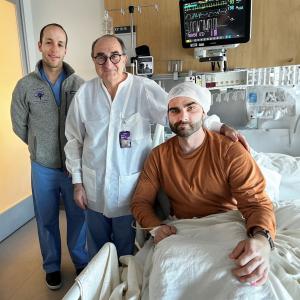Findings Could Lead to New Drug Development & Personalized Treatment Strategies for Severe Epilepsy
Genetic mutations that may cause severe childhood epilepsies have been identified in crucial nerve cell structures by an international team of researchers organized by NYU Langone Medical Center epilepsy experts.
A international research team organized and co-led by Ruben Kuzniecky, MD, Co-Director of the NYU Comprehensive Epilepsy Center, found new causative gene mutations that affect the functioning of the synapse, a vital structure that facilitates communications among nerve cells. These mutations were found in some patients to be causative of severe epilepsy.
The team of U.S. and European scientists performed the largest collaborative study to date focused on the genetic roots of severe epilepsies. Their findings were published online Sept. 25 in the American Journal of Human Genetics.
"We knew that synaptic genes were important in epilepsy, but not to this extent," says Kuzniecky, a professor of neurology at NYU School of Medicine who serves as Co-Principal Investigator of the Epilepsy Genome Phenome Project (EPGP). "With these findings, there is tremendous potential for new drug development and personalized treatment strategies for severe epilepsy -- which will happen sooner than later."
Epilepsies are among the most common disorders of the central nervous system, affecting up to 3 million U.S. patients. Up to one-third of all epilepsies resist treatment with antiepileptic medication and may be associated with other disabilities such as intellectual impairment and autism. Severe epilepsies are particularly devastating in children, and for many patients, no cause for the seizures can be identified.
There is increasing evidence that genetic factors may play a causal role in severe epilepsies. The current study, made possible through the collaboration of two international research consortia including the NINDS-funded EPGP/Epi4K consortium and the European EuroEPINOMICS consortium, assessed the role of genetic factors in the largest group of patients with severe epilepsy identified to date.
For the study, researchers sequenced the genomes of 356 patients with severe childhood epilepsies and those of both of their parents. Researchers looked for genes that had acquired new mutations in the children with severe epilepsies. In total, they identified 429 new mutations and in 12 percent of children, these mutations were considered unequivocally causative for the patient's epilepsy. In addition to several known genes for childhood epilepsies, the research team found strong evidence for additional novel genes, many of which are involved in the function of the synapse.
Researchers used a method called family-based exome sequencing, which looks at the part of the human genome that serves as the blueprints for proteins. When comparing the sequence information in children with epilepsy with that of their parents, the researchers were able to identify changes that arose in the genomes of the affected children. These "de novo" changes are increasingly recognized as the genetic cause for severe seizure disorders, but not all changes identified are necessarily pathogenic.
The most surprising finding was a gene called Dynamin 1, which was found to be mutated in five patients. Dynamins are structural proteins, which play a role in shuttling small vesicles between the body of the neuron and the synapse. When the researchers looked on a network level, they found that many of the genes that were found to be mutated in patients had a clear connection with the function of the synapse.
"This finding represents a paradigm shift, which gives us new hope for targeting our treatment strategies," said Dr. Kuzniecky. Finding new molecules that can circumvent or overcome the limitations imposed by this mutation may be the achievable in the very near future, he added.
Dr. Tracy Dixon-Salazar, associate research director at Citizens United for Research in Epilepsy (CURE), a non-profit dedicated to finding a cure for epilepsy and increasing awareness of the disease, applauded the collaboration. "This clearly highlights that by working together, we can find new genes faster, helping us to explain what causes this devastating disease in children," she says.
The largest number of patients in the multicenter EPGP/EPI4K study came from the NYU Comprehensive Epilepsy Center (> 10 percent) and the seed grant for the study was funded earlier by FACES (Finding A Cure For Epilepsy & Seizures), an organization affiliated with NYU Langone Medical Center. FACES funds research to improve epilepsy care, advances new therapies, and fosters a supportive community for children, families and caregivers who live with the challenges of epilepsy.

